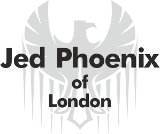 It may be surprising today but Goth did not start out as the fantastic funeral parade we know. When the scene grew out of the stew that was post Punk, Goths wore many colours. There was no overarching style, the identifier for the post punk scene that centred on the Bat Cave was highly individualistic but had no overall look; individual style was the name of the game. Goth was just forming, hot and runny it had not truly taken any concrete form, without knowing it it was waiting for a group of boys from Northampton to work their magic. Whilst there were bands, most notably UK Decay, who wore all black, but they did so for practical purposes; it hid the dirt better! Most of the more clothing associated with Goth began as stage wear, but found its way into fashion later. Makeup started as a form of war paint, key to defining the defiant edge of Goth.
It may be surprising today but Goth did not start out as the fantastic funeral parade we know. When the scene grew out of the stew that was post Punk, Goths wore many colours. There was no overarching style, the identifier for the post punk scene that centred on the Bat Cave was highly individualistic but had no overall look; individual style was the name of the game. Goth was just forming, hot and runny it had not truly taken any concrete form, without knowing it it was waiting for a group of boys from Northampton to work their magic. Whilst there were bands, most notably UK Decay, who wore all black, but they did so for practical purposes; it hid the dirt better! Most of the more clothing associated with Goth began as stage wear, but found its way into fashion later. Makeup started as a form of war paint, key to defining the defiant edge of Goth.
The influence of music and film on gothic fashion
Bauhaus provided the catalyst that gelled everything together, the black clothes and hair, the pallor and the makeup; the music. Gothic fashion had inherited legacy items from both Punk and Glam Rock, those trousers, those hulking boots, and they quickly became integrated into the aesthetic, but the other aspects of both those scenes were rejected as Goth became its own thing. Once the Bat Cave days were over, a harder edge began to evolve both in the music, as the playful sounds of Specimen, Alien Sex Fiend and Bauhaus were supplanted by The Southern Death Cult (who's ever shortening name soon rendered them simply just The Cult) this element, something definitely changed when the music industry turned its back at the end of the decade. This proved to be a merciful release in many ways, allowing new voices and directions to evolve. Whilst the world wasn't watching new concepts were explored and it's from this period rather than the Eighties that many of the things we take for granted really started to be adopted by the second wave of Goth. This is where the BDSM influences and the historical costuming really started to make their presence felt in gothic fashion. Film played its part too, I'm not convinced that the look inspired by the Crow would have been so popular had Goth remained in the public eye. The clown makeup and long black coat became must haves for men in a blisteringly short amount of time. The same is true of the vampire look, boosted surely by Interview with a Vampire? Film and other influences began to be far more important than the influence of bands in terms of shaping the way Goths dressed.
Gothic fashion in the media and into the present day
This does nod towards an interesting paradox, whilst music hated, and arguably still does hate, Goth, fashion and film embraced it. By the middle of the Nineties the Observer had fashion spreads that, whilst they didn't dare to print the G word, just happened to have thin, glamorous girls in a black clothes hanging around in a graveyard. There has always been more support for the fashion side of things than for any other part.
On the scene the Nineties saw new elements arise, often from surprising places. The Japanese influence made itself felt via Gothic Lolita, cute and creepy in a single package; little girl looks for adults. Then too, there was Cyber Goth,
which combined Rave and Goth and conjures us images of Goths wearing gas masks and goggles before  Steampunk even broke cover (I'm reliably informed that the roots of that subculture lie somewhere in the early Nineties too).
Steampunk even broke cover (I'm reliably informed that the roots of that subculture lie somewhere in the early Nineties too).
The Noughties saw something of a revival of the Goth scene in the mainstream, as bands like the Horrors formed. Classic staples of Goth attire became fashionable again, this time with an added military angle as the retro Napoleonic look popularised by My Chemical Romance crept in; merely confirming much of the hodge podge that alternative fashion has become, where several styles can lay claim to the same clothing.
All of which brings us to the current situation, where all the expressions of Goth are pretty much acceptable, and all looks are valid as long as they are authentic. Whether your look is basic, flamboyant, perverted or historical; there is a place for it. It allows you to show the world who you truly are.
This article on Goth fashion was written by Steve Cotterill, a writer, gamer and steampunk/goth. His blog is called Shores of Night.
